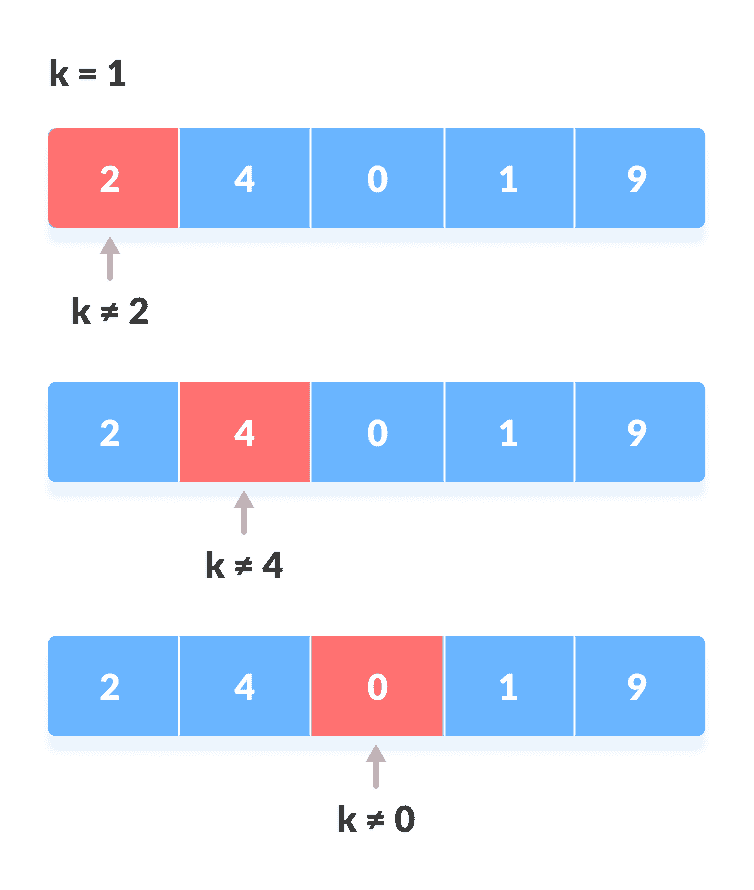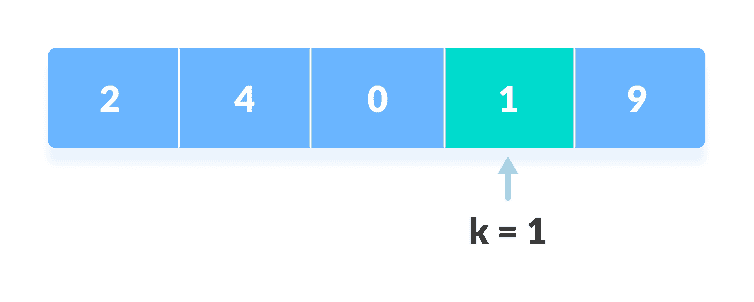在本教程中,您将学习线性搜索。 此外,您还将找到线性搜索 C,C++ ,Java 和 Python 的工作示例。
线性搜索是最简单的搜索算法,可以按顺序搜索列表中的元素。 我们从一端开始,检查每个元素,直到找不到所需的元素。
线性搜索如何工作?
按照以下步骤在下面的列表中搜索元素k = 1。

要搜索的数组
从第一个元素开始,将
k与每个元素x进行比较。
与每个元素比较如果为
x == k,则返回索引。 找到
元素否则,返回
"not found"。
线性搜索算法
LinearSearch(array, key)for each item in the arrayif item == valuereturn its index
Python,Java 和 C/C++ 示例
# Linear Search in Pythondef linearSearch(array, n, x):# Going through array sequenciallyfor i in range(0, n):if (array[i] == x):return ireturn -1array = [2, 4, 0, 1, 9]x = 1n = len(array)result = linearSearch(array, n, x)if(result == -1):print("Element not found")else:print("Element found at index: ", result)
// Linear Search in Javaclass LinearSearch {public static int linearSearch(int array[], int x) {int n = array.length;// Going through array sequenciallyfor (int i = 0; i < n; i++) {if (array[i] == x)return i;}return -1;}public static void main(String args[]) {int array[] = { 2, 4, 0, 1, 9 };int x = 1;int result = linearSearch(array, x);if (result == -1)System.out.print("Element not found");elseSystem.out.print("Element found at index: " + result);}}
// Linear Search in C#include <stdio.h>int search(int array[], int n, int x) {// Going through array sequenciallyfor (int i = 0; i < n; i++)if (array[i] == x)return i;return -1;}int main() {int array[] = {2, 4, 0, 1, 9};int x = 1;int n = sizeof(array) / sizeof(array[0]);int result = search(array, n, x);(result == -1) ? printf("Element not found") : printf("Element found at index: %d", result);}
// Linear Search in C++
#include <iostream>
using namespace std;
int search(int array[], int n, int x) {
// Going through array sequencially
for (int i = 0; i < n; i++)
if (array[i] == x)
return i;
return -1;
}
int main() {
int array[] = {2, 4, 0, 1, 9};
int x = 1;
int n = sizeof(array) / sizeof(array[0]);
int result = search(array, n, x);
(result == -1) ? cout << "Element not found" : cout << "Element found at index: " << result;
}
线性搜索的复杂度
时间复杂度: O(n)
空间复杂度: O(1)
线性搜索应用
- 用于较小数组中的搜索操作(
< 100个项目)。

